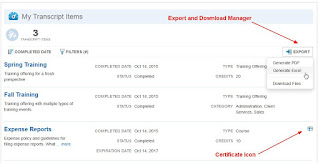Oracle Learn Cloud (Taleo Learn) v16B will be available on July 22nd, 2016. The release content document can be found in the below link:
http://www.oracle.com/webfolder/technetwork/tutorials/tutorial/cloud/taleo/16B_learn_rcd.htm
A quick summary of the new features:
http://www.oracle.com/webfolder/technetwork/tutorials/tutorial/cloud/taleo/16B_learn_rcd.htm
A quick summary of the new features:
- New supervisor role feature: One common role to maintain supervisor permissions. This role will also be assigned to all users mapped as supervisors. For existing implementations with an integration to bring in users into Learn, you will need to do an impact analysis of how this new role will affect the permissions assigned to supervisors brought in by integration.
- Search and Skill widgets: Continuing investment in the new "widgets" feature, 16B will see two new widgets - Search and Skill. The new widgets present an opportunity for existing implementations to provide a more modern user interface for some of the existing features. Most Learn customers will be having a "Search" feature, utilising the tradtional LearnCenter Search Dynamic Object. Evaluate the new widgets to see how the existing pages can be redesigned to incorporate the new widgets.
- OOTB user interface between Learn and TBE: An out of the box interface is now provided for customers using TBE to bring over user data to Learn. Note that there is a significant change in the integration strategy for new Learn projects with the adoption of REST API services. While this does not affect existing customers for the moment, current and future implementations will need to consider the impact of this change.
- General availability of the new SCORM course player: A new course player was introduced in earlier releases, with support for HTML 5 content. This has now emerged from BETA and is available for courses launched from the "Learning Plan", "Tasks" and "Transcript" widgets.
If you are an existing Learn customer, review the release content documents and carry out a release impact analysis at the earliest. As always, make use of the robust community in Customer Connect to raise any questions or issues you have during the upgrade.












